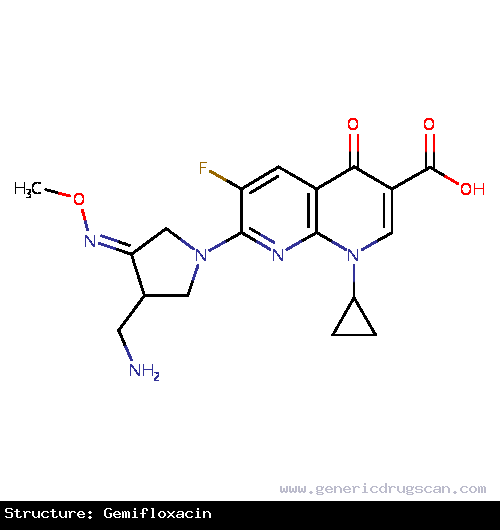Gemifloxacin Drug: Indication, Dosage, Precaution, Side Effect , Storage, Category Type and corresponding Brands - www.genericdrugscan.com
Gemifloxacin
Drug Status in USA : ApprovedDrug Status in Canada : Approved
pronunciation
pronounced as (gem ah flox' a sin)
Why is this medication prescribed?
Gemifloxacin is used to treat certain infections such as pneumonia or bronchitis. Gemifloxacin is in a class of antibiotics called fluoroquinolones. It works by killing bacteria that cause infections. Antibiotics do not work for colds, flu, or other viral infections.
How should this medicine be used?
Gemifloxacin comes as a tablet to take by mouth. It is usually taken with or without food once a day for 5 or 7 days. The length of your treatment depends on the type of infection you have. Your doctor will tell you how long to take gemifloxacin. Take gemifloxacin at around the same time every day. Follow the directions on your prescription label carefully, and ask your doctor or pharmacist to explain any part you do not understand. Take gemifloxacin exactly as directed. Do not take more or less of it or take it more often than prescribed by your doctor.
Swallow the tablets whole with plenty of water; do not split, chew, or crush them.
You should begin feeling better during the first few days of treatment with gemifloxacin. If your symptoms do not improve or if they get worse, call your doctor.
Take gemifloxacin until you finish the prescription, even if you feel better. Do not stop taking gemifloxacin without talking to your doctor unless you experience certain serious side effects that are listed in the IMPORTANT WARNING and SIDE EFFECTS sections. If you stop taking gemifloxacin too soon or skip doses, your infection may not be completely treated and the bacteria may become resistant to antibiotics.
What are the precautions to be followed?
Before taking gemifloxacin,- tell your doctor and pharmacist if you are allergic or have had a severe reaction to gemifloxacin or any other quinolone or fluoroquinolone antibiotics such as ciprofloxacin (Cipro), gatifloxacin (Tequin) (not available in the U.S.), levofloxacin (Levaquin), lomefloxacin (Maxaquin) (not available in the U.S.), moxifloxacin (Avelox), nalidixic acid (NegGram), norfloxacin (Noroxin), ofloxacin (Floxin), and sparfloxacin (Zagam) (not available in the U.S.); any other medications; or if you are allergic to any of the ingredients in gemifloxacin. Ask your pharmacist or check the Medication Guide for a list of the ingredients.
- tell your doctor and pharmacist what other prescription and nonprescription medications, vitamins, nutritional supplements, and herbal products you are taking or plan to take. Be sure to mention the medications listed in the IMPORTANT WARNING section and any of the following: anticoagulants ('blood thinners') such as warfarin (Coumadin, Jantoven); certain antidepressants; antipsychotics (medications to treat mental illness); cisapride (Propulsid) (not available in the U.S.); diuretics ('water pills'); erythromycin (E.E.S., E-Mycin, Erythrocin, others); hormone replacement therapy; certain medications for irregular heartbeat such as amiodarone (Cordarone), procainamide (Procanbid), quinidine, and sotalol (Betapace, Betapace AF, Sorine); nonsteroidal anti-inflammatory drugs (NSAIDs) such as ibuprofen (Advil, Motrin, others) and naproxen (Aleve, Naprosyn, others); or probenecid (in Col-Probenecid, Probalan). Your doctor will need to change the doses of your medications or monitor you carefully for side effects.
- if you are taking antacids containing aluminum hydroxide or magnesium hydroxide (Maalox, Mylanta, Tums, others); didanosine (Videx); sucralfate (Carafate); or vitamin or mineral supplements that contain iron, magnesium, or zinc, take these medications 3 hours before or 2 hours after you take gemifloxacin.
- tell your doctor if you or anyone in your family has or has ever had a prolonged QT interval (a rare heart problem that may cause irregular heartbeat, fainting, or sudden death) or an irregular heartbeat, and if you have or have ever had nerve problems, a low level of potassium or magnesium in your blood, seizures, cerebral arteriosclerosis (narrowing of blood vessels in or near the brain that can lead to stroke or ministroke), a slow heartbeat, chest pain, or liver disease.
- tell your doctor if you are pregnant, plan to become pregnant, or are breast-feeding. If you become pregnant while taking gemifloxacin, call your doctor.
- you should know that gemifloxacin may cause confusion, dizziness, lightheadedness, and tiredness. Do not drive a car, operate machinery, or participate in activities requiring alertness or coordination until you know how this medication affects you.
- plan to avoid unnecessary or prolonged exposure to sunlight or ultraviolet light (sunlamps or tanning beds) and wear protective clothing, sunglasses, and sunscreen. Gemifloxacin may make your skin sensitive to sunlight or ultraviolet light. If your skin becomes reddened, swollen, or blistered, like a bad sunburn, call your doctor.
What are possible side effects of this medication ?
Gemifloxacin may cause side effects. Tell your doctor if any of these symptoms are severe or do not go away:- diarrhea
- nausea
- stomach pain
- vomiting
- headache
- severe diarrhea (watery or bloody stools) that may occur with or without fever and stomach cramps (may occur up to 2 months or more after your treatment)
- lightheadedness
- dizziness
- hallucinations (seeing things or hearing voices that do not exist)
- not trusting others or feeling that others want to hurt you
- depression
- thoughts about dying or killing yourself
- restlessness
- confusion
- nervousness
- anxiety
- difficulty falling asleep or staying asleep
- nightmares
- uncontrollable shaking of a part of the body
- rash
- hives
- itching
- peeling or blistering of the skin
- fever
- swelling of the eyes, face, mouth, lips, tongue, throat, hands, feet, ankles or lower legs
- hoarseness
- difficulty breathing or swallowing
- fast heartbeat
- fainting
- loss of consciousness
- yellowing of the skin or eyes
- dark urine
- decreased urination
- seizures
- unusual bruising or bleeding
- joint or muscle pain
Gemifloxacin may cause problems with bones, joints, and tissues around joints in children. Gemifloxacin should not be given to children younger than 18 years of age.
Gemifloxacin may cause nerve damage that may not go away even after you stop taking gemifloxacin. This damage may occur soon after you begin taking gemifloxacin. If you experience any of the following symptoms, call your doctor immediately: numbness, tingling, pain, or burning in the arms or legs; or a change in your ability to feel light touch, pain, heat, or cold. If you experience these symptoms, do not take any more gemifloxacin until you talk to your doctor. Your doctor may prescribe a different antibiotic for you to take instead of gemifloxacin.
Talk to your doctor about the risks of taking gemifloxacin or giving gemifloxacin to your child.
Gemifloxacin may cause other side effects. Call your doctor if you have any unusual problems while taking this medication.
How to store the medication and dispose it of after its use later?
Keep this medication in the container it came in, tightly closed, and out of reach of children. Store it at room temperature and away from light and excess heat and moisture (not in the bathroom).
Unneeded medications should be disposed of in special ways to ensure that pets, children, and other people cannot consume them. However, you should not flush this medication down the toilet. Instead, the best way to dispose of your medication is through a medicine take-back program.
Drug Category/Class
- Quinolones
- Fluoroquinolones
- Quinolone Antibacterials
- Quinolone and Quinoxaline Antibacterials
- Topoisomerase II Inhibitors
- Antibacterials for Systemic Use
- Antiinfectives for Systemic Use
- Anti-Bacterial Agents
- Fluoroquinolones
| Prescribed | For the treatment of bacterial infection caused by susceptible strains such as S. pneumoniae, H. influenzae, H. parainfluenzae... |
| Weight : | 389.3809 |
| Structure | Gemifloxacin |
 | |
| Formula | C18H20FN5O4 |
Gemifloxacin has 35 Brands listed
Search Generic Drugs alphabetically
